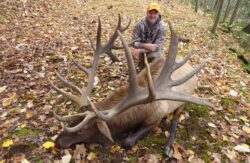For some hunters, harvesting an elk, any elk, is the thrill land “Trophy”, of a lifetime. Other hunters that have tagged several Bulls, may hunt with a different purpose. They will pass up cows and smaller bulls with dreams of a massive “trophy”.
What is a “Trophy Bull Elk”? This is in the eye of the hunter. For most experienced elk hunters, Trophy begins at a 6 x 6 rack. This represents a mature bull. A younger mature bull, say 4-5 years old, is a far bugle from a bull over 8 years old.
Another way to define trophy is by using the Pope and Young score. This measurement system looks at width, height, tines, tine length, and beam thickness. A bull measuring over 250 points is a nice bull in anyone’s book.
Trophy takes on a different meaning when considering archery, rifle, or black powder hunts. When you look at the BIG records of trophy bulls, which measure out at 375 and over, a 250-point elk seems small.
Generally, any bull over 300 points is a monster. This sized bull will usually be good eating as well. Once you look at bigger bulls, the quality of the meat declines. Huge bulls have purple, string, tough meat. Even grind lacks flavor and tenderness.
Many outfitters and guides offer “Trophy Hunts”. This is also a variation. What is a trophy in the Missouri Breaks is different than a trophy from the Bridger’s. The hunting style and technique will also be different. Sometimes just seeing elk or getting a shot at any elk is a “trophy hunt”.
If you are truly after a monster elk, you need to hunt an area where elk can survive to become a monster elk. This eliminates most public lands. You need to find an isolated, remote area that also has the habitat and genetics to become a monster bull. This is not easy.
Montana has just 61 or so trophy bulls that have made the record books. These bulls are over 350 points, and some exceed 400! Most of these bulls are between 7-11 years old. After that age, bull size and quality tend to decline.
Ideally, find an area where you have around 20 bulls per 100 cows. In that population, you have a decent chance of finding a Trophy. These areas have proper genetics, soil minerals, and decent winter range. Primo areas will be along fringe areas, not deep wilderness. Locate areas that are too small to be of interest to outfitters. These honey holes will be found in roadless drainages, between private properties, or in quality managed hunting zones.
For me, the greatest trophies are the memories of the great hunters that I spent time in camp and afield with. Big elk will come but the “hunt” is the real trophy adventure.
Trophy hunters will kill less game, but they have an opportunity to satisfy their personal dreams.
Montana Grant